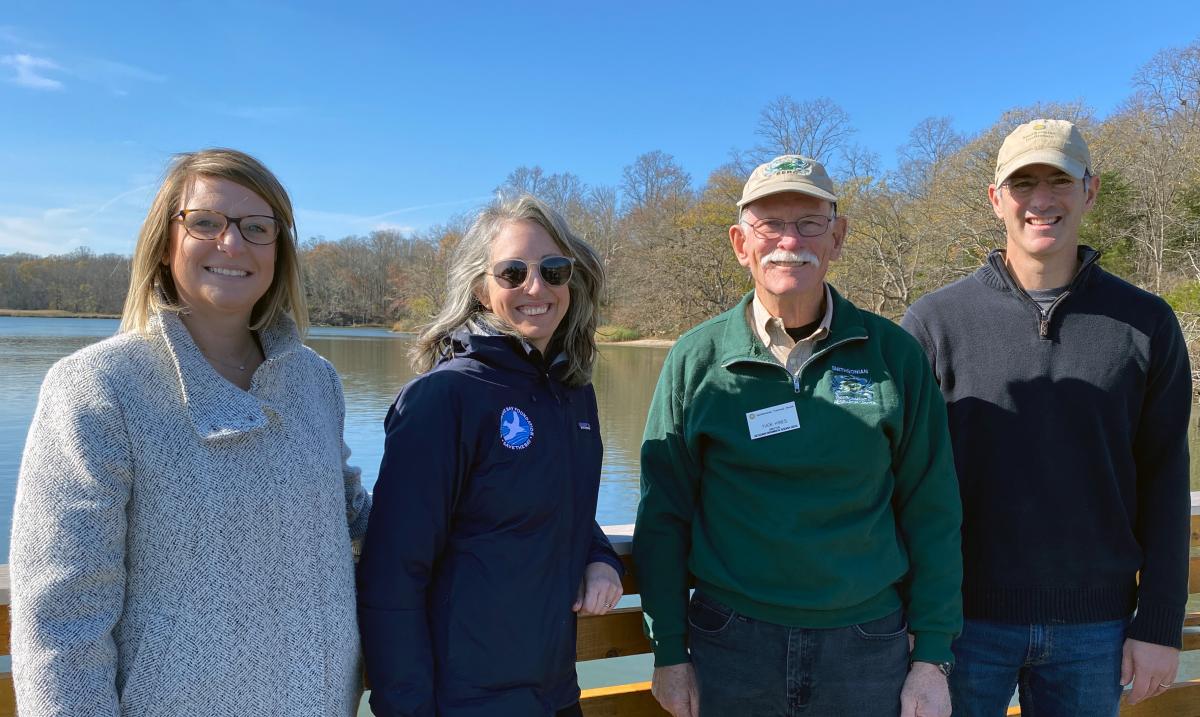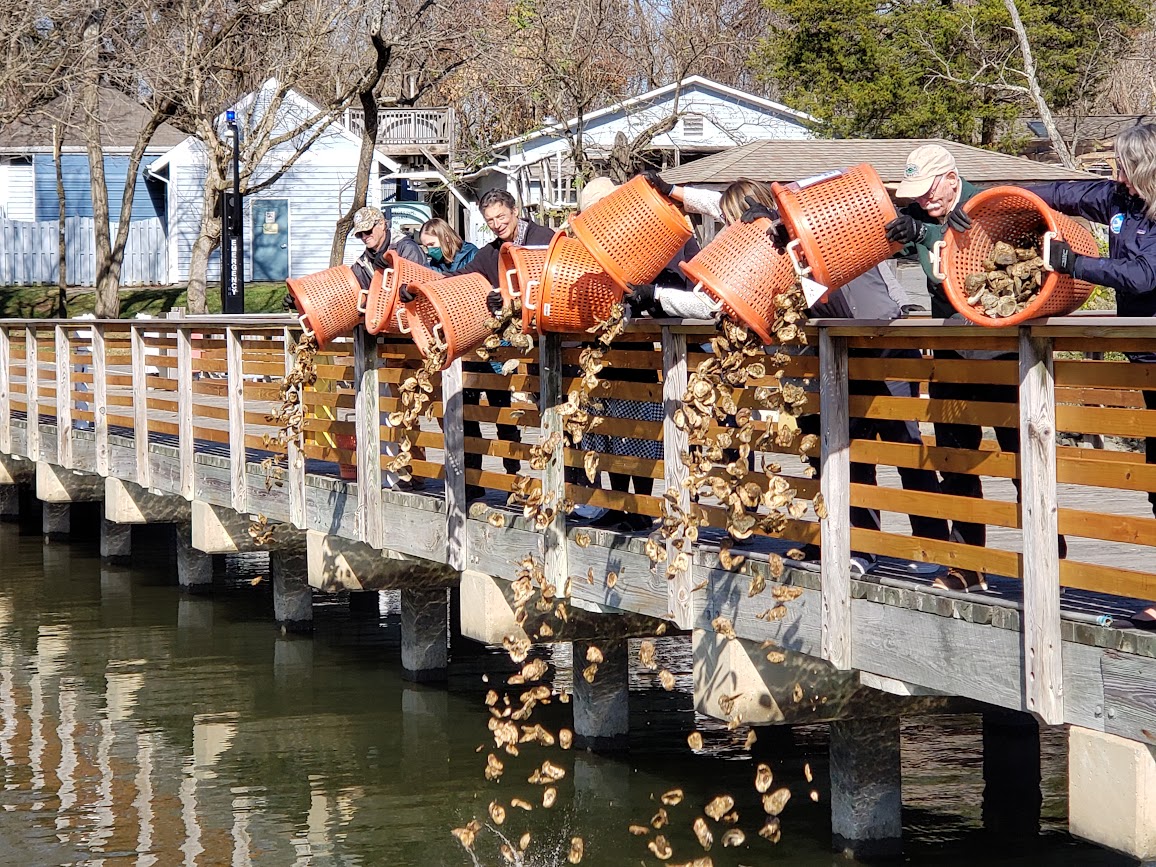Original source: A. J. Metcalf, Chesapeake Bay Foundation
The Smithsonian Environmental Research Center (SERC) and the Chesapeake Bay Foundation (CBF) announced a new partnership centered on oyster restoration Nov. 14.
The partnership includes relocating the foundation’s oyster restoration center to the SERC campus in Edgewater, Maryland. The restoration center will produce spat-on-shell oysters and “reef balls”—giant concrete domes with holes to provide hard surface for young oysters to settle on and safe hiding places for fish and other aquatic life. SERC and the foundation will work collaboratively to expand research opportunities, train students and promote the Chesapeake Bay’s restoration through this new partnership.

Left to right: CBF Maryland Fisheries Scientist Allison Colden, CBF President Hilary Falk, SERC Director Tuck Hines, and SERC Senior Scientist Matt Ogburn on the SERC docks. (Credit: A.J. Metcalf/Chesapeake Bay Foundation)
SERC’s research into the challenges facing coastal areas worldwide, including climate change, invasive species and pollution threats to ecosystems, will help inform CBF’s ongoing efforts to restore oysters and increase reef habitat in the bay.
“This new partnership of SERC and CBF brings a strong blend of research and public engagement for restoring oysters in the bay—a crucial step in rebuilding the co-benefits of healthy oyster reefs,” said SERC Director Tuck Hines. “SERC’s base in the Rhode River provides ready access to new restoration sites on the Western Shore, where we can engage more people as volunteer scientists in regenerating biodiversity and ecosystems services for the bay. Going forward, CBF’s spat on-shell production process and the vessel R/V Patricia Campbell will allow SERC to apply rigorous experiments at a scale to test new ideas about the complex interactions of reef design. Our partnership provides a model of collaboration that can be scaled up and replicated throughout the Chesapeake and beyond.”
CBF has coordinated Chesapeake Bay oyster restoration efforts for over 20 years and has added more than 332 million spat, or juvenile oysters, to reefs throughout the bay. Previously, the foundation’s Maryland Oyster Restoration Center was located at Discovery Village in Shady Side, Maryland.
“We’re so thankful our oyster restoration program has found a new home at SERC on the shores of the Rhode River,” said CBF President Hilary Falk. “We hope this partnership will usher in a new era of collaboration between our organizations to expand oyster restoration efforts and advance cutting-edge oyster science.”
CBF and SERC plan to engage volunteers, schoolchildren, teachers, college students and others to learn about and help with oyster restoration efforts through hands-on activities. The foundation will dock its specially designed oyster restoration vessel, the R/V Patricia Campbell, at the facility’s pier on the Rhode River.
On Monday, Nov. 14, CBF and SERC leaders and staff celebrated the new partnership by planting more than 200,000 oysters on a reef near the SERC dock that was first built by the foundation for SERC research activities in 2006.

Staff from SERC and the Chesapeake Bay Foundation dump oysters off the SERC docks, to add to SERC’s restoration reef in the Rhode River. (Credit: Karen McDonald/SERC)
Oyster restoration efforts in the bay are focused on bringing back the species following widespread loss. Oyster population levels have declined dramatically since the 1800s due to a combination of overharvesting, pollution and disease—leading scientists to estimate there are less than 1% of preindustrial levels of oysters remaining in the bay.
Increasing oyster populations would be a boon for the overall bay ecosystem, which benefits from oysters’ natural ability to filter water and build habitat. Fish, crabs and other marine species often use the nooks in oyster reefs to hide from predators and scour the reefs for food.
In addition to adding oysters to the bay, CBF’s advocacy efforts have helped permanently protect Maryland’s five large-scale oyster restoration tributaries and loosen regulations surrounding oyster aquaculture to promote new sustainable business opportunities. The foundation also leads the Chesapeake Oyster Alliance, a group of nonprofits, community organizations and oyster growers working toward a goal of adding 10 billion oysters to the bay by 2025.
“Collaboration between scientists, fishery managers and restoration practitioners is key to reversing the historic decline of oysters,” said Allison Colden, CBF’s Maryland senior fisheries scientist. “We’re pleased to have SERC as a new partner in our oyster restoration efforts. SERC’s cutting-edge research and scientific monitoring abilities will complement CBF’s capabilities to carry out large-scale oyster restoration throughout the bay.”
Scientists at SERC are studying oyster reef ecosystems by examining fish and crab use of restored reefs off Maryland’s Eastern Shore—the home of the world’s largest oyster restoration project—and comparing that use to harvested and natural reefs elsewhere. Researchers are using advanced sonar technology, baited traps and other data sources to evaluate reef habitat use. SERC scientists are also tracking oyster disease throughout the Chesapeake in the Coastal Disease Ecology Lab.
“We are excited to work with CBF to study oyster restoration and especially how the restored reef systems function to support the diversity of fish, crabs and other species in Chesapeake Bay,” said SERC senior scientist Matt Ogburn, who leads the center’s Fisheries Conservation Lab. “SERC’s small reef will continue to serve as a test bed for our research methods and as a tool for our education programs.”
Watch: SERC's underwater cameras compare oyster habitat at Harris Creek restoration and Broad Creek harvest area
Media Contact
Kristen Goodhue, Smithsonian Environmental Research Center (goodhuek@si.edu)
A. J. Metcalf, Chesapeake Bay Foundation (ametcalf@cbf.org)
